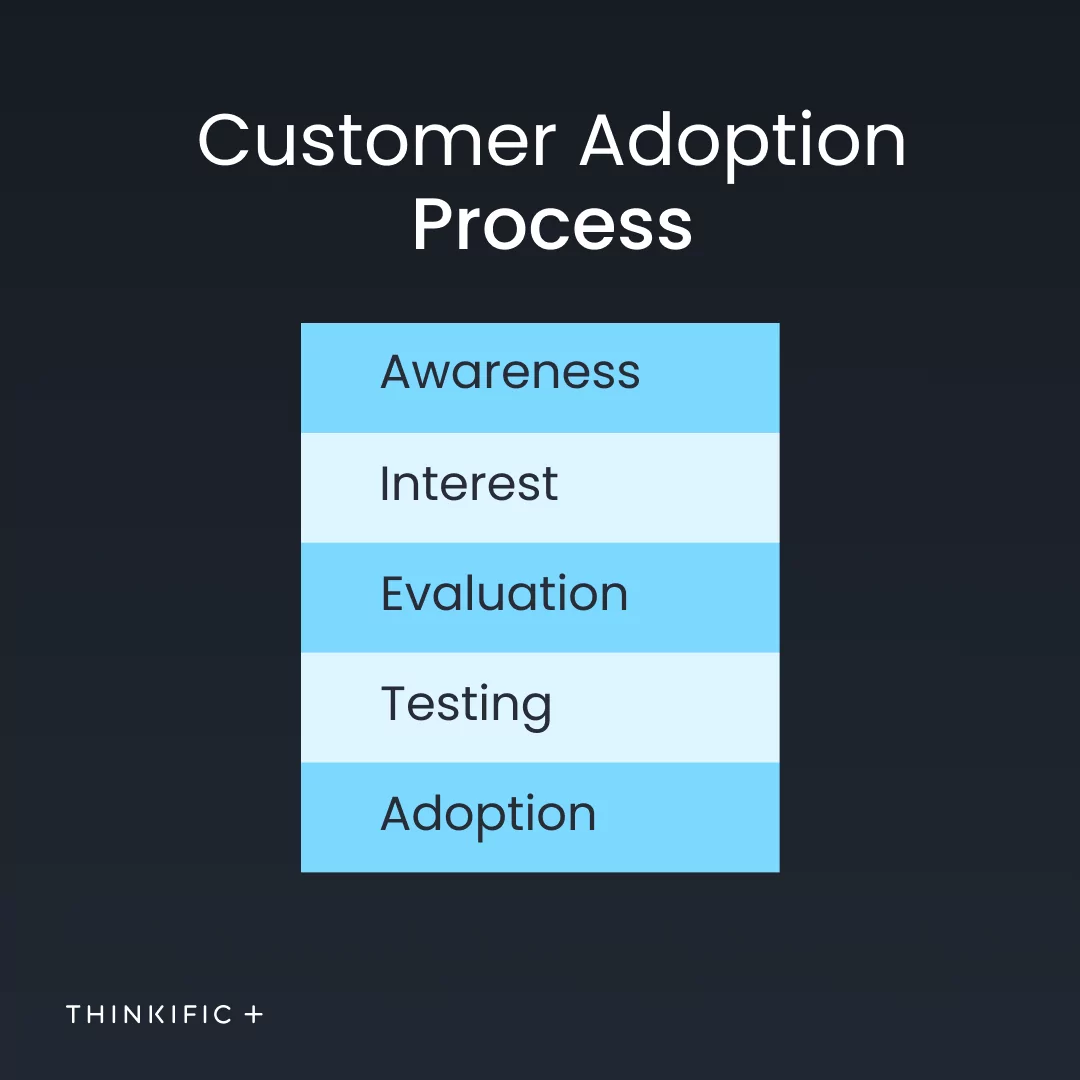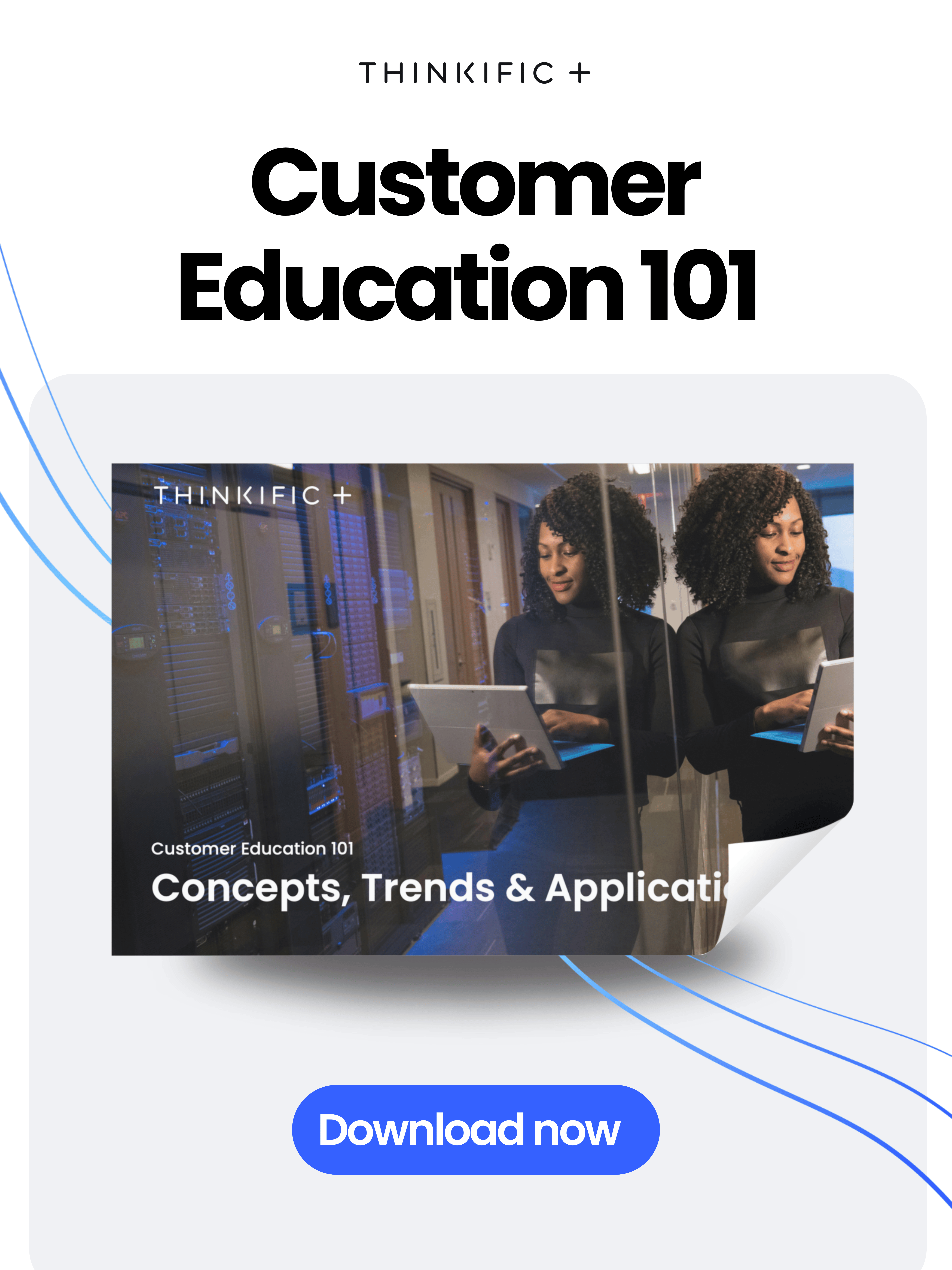You’ve launched a product, but success doesn’t end at launch—it begins with customer adoption. Ensuring customers understand and integrate your product into their workflow is crucial for retention, account expansion, and overall growth.
In this customer adoption strategy, we’ll break down what customer adoption means, how it connects to long-term success, and the steps you can take to guide customers through the product adoption process through strategic customer education.
Skip ahead:
What is customer adoption?
Customer adoption is the process where customers discover, engage with, and incorporate your product into their daily operations. From initial awareness to consistent, value-driven use, this process is key to ensuring long-term success. The product adoption curve helps outline the different stages customers move through on their journey to full adoption.
The goal is to introduce something new and guide customers through the entire process—from discovery to regular use.
Customer adoption also measures how quickly and efficiently customers can adapt to using your product as intended. For customer success teams, understanding and optimizing this process is crucial for driving retention, expanding accounts, and ensuring long-term customer satisfaction.
Customer adoption vs. production adoption
While customer adoption and product adoption are closely related, they focus on different aspects of the adoption process.
- Customer adoption: Focuses on how well customers integrate your product into their workflow, ensuring they get ongoing value.
- Product adoption: Tracks when users start using your product for its intended purpose, often marked by specific behaviors.
Both processes are essential for business success, but this article focuses on customer adoption strategy—helping your customers see and experience the value of your product, leading to long-term loyalty and growth.
The link between customer adoption, retention, and account expansion
Customer adoption is the foundation of sustainable business growth and long-term success. When your customers fully adopt and integrate your product into their daily operations, they’re more likely to stay engaged, reducing the churn risk.
This directly impacts customer retention. Customers who use your product consistently and get real value are far more likely to continue their subscriptions, renew contracts, and engage in account expansion opportunities. The key to driving higher customer retention is ensuring consistent value through product adoption metrics, allowing customers to renew subscriptions, upgrade to premium plans, and explore additional features.
Strong customer adoption doesn’t stop at retention—it fuels growth.When customers consistently experience value, they are more inclined to invest in additional features or upgrade to comprehensive solutions, making cross-sell and upsell opportunities more achievable.
Understanding the customer adoption curve
The customer adoption curve outlines the stages customers go through when adopting a new product, with each group showing different levels of openness to trying something new. Understanding these stages helps you tailor your educational strategies to meet customers where they are and provide the right support at each point in their journey.
Innovators
Innovators are the first to adopt new products. They’re highly motivated to try new products and enjoy experimenting with early versions and are comfortable enough to provide feedback, even if the product isn’t fully refined. These customers are often excited to experiment with the latest features and provide valuable feedback.
At this stage, offer exclusive access to beta programs, product documentation, and early-stage tutorials. Innovators thrive on being early adopters, so providing in-depth guides and early-stage webinars encourages them to explore and share feedback.
Early adopters
Early adopters are similar to innovators but tend to be more cautious. They’re open to new solutions but need to see the product’s potential before fully committing. Often seen as opinion leaders, they are more likely to invest if they see tangible benefits early on.
To engage early adopters, provide case studies, advanced tutorials, and demos highlighting the product’s potential benefits. These customers value deeper insights, so offering comprehensive online courses or webinars that showcase practical use cases can build their confidence in adopting the product.
Early majority
The early majority adopts products once they’ve been proven to work. They seek stability and clear evidence that the product will solve their problems. This group is pragmatic and needs solid assurance that the product delivers on its promises.
For the early majority, provide structured learning paths, onboarding programs, and clear use case examples. Step-by-step product guides, hands-on demos, and certifications will help them feel confident about adopting your product.
Late majority
The late majority is more conservative and cautious about adopting new products. They tend to wait until others widely accept and validate the product. They need solid proof of reliability and often look for reassurance from peer reviews or data.
In this stage, provide detailed onboarding materials, customer success stories, and data-driven case studies demonstrating how others have successfully implemented the product. Simplify the adoption process with easy-to-follow tutorials and ongoing support, helping them feel secure in their decision.
Laggards
Laggards resist change and only adopt new products when they absolutely must. This group is hesitant due to low-risk tolerance or satisfaction with their current solutions, and they require strong reassurance and support.
For laggards, offer personalized onboarding and customer support. Simplify the transition with clear, concise guides and one-on-one training sessions addressing their concerns. This group needs continuous guidance and patience to feel comfortable adopting a new product.
5 steps of the customer adoption process
The customer adoption process is a journey that guides users from discovering your product to fully integrating it into their workflow. Understanding these five key stages helps provide your customers with the right support and educational resources at each point.

1. Product awareness
Product awareness is the first step in the customer adoption process. At this stage, customers become aware of your product or a new feature, typically through marketing emails, product notifications, or communication from a Customer Success Manager (CSM).
The goal here is to provide clear, concise information that introduces the product’s key benefits. Educational content such as product guides, introductory videos, and blog posts can help make a solid first impression, showing customers how your product can bring value and meet their needs.
2. Product interest
In the product interest stage, customers are curious about how your product or feature can benefit them. After receiving a promotional update, they might reach out for more information or express interest.
To encourage this interest, offer deeper insights. Educational tools like webinars, detailed use cases, and feature breakdowns help customers understand how your product fits into their workflows. This phase sets the stage for customers to move from interest to evaluation.
3. Product evaluation
During product evaluation, customers assess whether your product is the right solution for them. This stage involves comparing your product to competitors and evaluating cost, return on investment, and alignment with their business needs.
Support this decision-making phase with in-depth educational resources like case studies, ROI calculators, and comparison guides. These materials help customers make an informed decision by addressing specific pain points and demonstrating your product’s real-world impact.
4. Product testing
Once customers show serious interest, they move to the product testing phase. This could involve a free trial, beta testing, or a demo. Here, customers get hands-on experience with your product, evaluating its features and how well it fits into their workflow.
During this phase, focus on offering tutorials, product walkthroughs, and FAQs to help customers quickly understand how to use key features. Onboarding support, including live sessions and customer success check-ins, can help users maximize their trial experience, bringing them closer to full product adoption.
5. Product adoption
Product adoption is the final stage, where customers fully commit to using your product. This could involve subscribing to a plan, purchasing, or integrating the product into their daily business processes.
For successful adoption, customers often need direct support. Personalized onboarding, one-on-one training, and regular check-ins from their CSM can help them use the product to its fullest potential. Continue offering advanced learning opportunities, like certifications and deeper training, to keep customers engaged and help them expand their usage over time.
The role of education in customer adoption
Customer education is crucial to successful adoption, retention, and account expansion. By offering the right educational resources at each stage of the customer adoption process, you equip your users with the knowledge they need to fully engage with your product, achieve their goals, and continue using your services over the long term.
Where education fits in the customer adoption process
Education bridges curiosity and consistent use at every step of the customer adoption process—from awareness to complete integration. Here’s how education supports each stage:
- Product awareness: During the awareness stage, customers are just learning about your product. Educational content like introductory videos, blog posts, and webinars can highlight the key benefits and features, helping users quickly grasp how your solution can meet their needs.
- Product interest: As interest grows, customers need deeper insight into how the product works. Offering online courses, detailed product guides, and tutorials can give customers a clearer understanding of your product’s capabilities, motivating them to explore further.
- Product evaluation: At this stage, customers are considering whether your product is the right fit. Case studies, use cases, and hands-on demonstrations allow them to evaluate how your solution has helped others and how it can deliver value to their specific business needs.
- Product testing: When customers enter testing, the right educational resources can make a huge difference in their experience. Tutorials, FAQs, and live support during trials or beta phases help users gain confidence and understand how to make the most of the product.
- Product adoption: As customers reach the adoption stage, onboarding and advanced training become critical. Personalized onboarding sessions, one-on-one training, and deeper learning materials let users integrate the product smoothly into their workflows and maximize its potential.
How education supports ongoing retention and expansion
Customer education doesn’t end with adoption. It plays an ongoing role in keeping users engaged and primed for account expansion.
- Retention: Continuous learning opportunities, such as advanced courses, webinars, and regular product updates, help customers explore more features and unlock additional value. When customers feel supported and see tangible results, they are far more likely to renew their contracts and remain loyal to your brand.
- Account expansion: Education also drives upsell and cross-sell opportunities. Providing content highlighting advanced features, premium options, or additional products subtly introduces customers to new ways of improving their results. Rather than using a hard sell, education helps users recognize the value of deepening their engagement with your company.
Incorporating education into your customer success strategy helps users maximize your product at every stage. It drives adoption while fostering long-term loyalty and growth, keeping customers informed, engaged, and confident in their product use.

How to track and measure customer adoption
Tracking product adoption metrics and customer adoption helps you identify which users are successfully adopting your product, which ones may need additional support, and where you can refine the overall adoption experience. You can fine-tune your strategies for ongoing customer success by measuring key metrics.
Key metrics for tracking customer adoption
To effectively monitor customer adoption, focus on three metrics: adoption rate, time to first action, and time to value.
Adoption rate: This metric shows how many customers have adopted a new product or feature compared to your total user base. It provides a high-level view of the effectiveness of your product launches and customer education efforts.
Formula: Customer adoption rate = (Number of customers who adopted the feature / Total number of customers) x 100
Time to first action: Time to first action measures how long it takes for users to take their first meaningful step with a new product or feature. A short time to first action indicates strong interest and engagement, while a longer time suggests potential barriers to entry.
Time to value: Time to value tracks how quickly customers experience the benefits of your product. It’s a crucial indicator of whether your onboarding and education programs work. The faster users reach a breakthrough moment, the more likely they will continue using the product and stay loyal.
Tools for tracking customer adoption
To measure customer adoption effectively, use tools that integrate with your product and customer education programs:
- Learning Management Systems (LMS): Platforms like Thinkific Plus allow you to track engagement with educational content. You can assess whether your customer education drives product adoption by monitoring course completions, quiz results, and time spent on learning materials.
- Product analytics tools: Tools such as Google Analytics, Mixpanel, or Pendo track user interactions, showing how often users log in, which features they engage with, and how frequently they return. This data helps you identify which features are adopted quickly and which may need further promotion or support.
- Customer success platforms: Systems like Gainsight or Totango track customer health scores, engagement, and product usage patterns. Integrating these platforms with your LMS and product analytics gives you a full picture of your customers’ adoption journey, allowing you to provide the right support at the right time.
Leveraging customer education for adoption insights
Customer education can also provide valuable insights into customer engagement. By analyzing how customers interact with your educational resources, you can identify opportunities to improve your product and customer success strategies.
- Effectiveness of educational content: By tracking which courses or materials correlate with higher adoption rates, you can refine your education strategy and focus on content that drives engagement.
- Completion rates: Low course completion rates indicate areas where customers are struggling, giving you the chance to improve content and address pain points early on.
- Knowledge gaps: If recurring support issues arise after users complete educational programs, it may point to gaps in your content that need to be addressed. Filling these gaps can boost both adoption and satisfaction.
Tracking these key metrics and leveraging insights from your customer education tools helps confirm that customers are successfully adopting your product and gaining maximum value. This drives higher retention, increased engagement, loyalty and long-term growth opportunities.
Building a strong customer adoption and retention strategy
Customer adoption is essential for the long-term success of your business. Guiding customers through each stage of the adoption process, from awareness to complete integration, with timely education, helps them adopt your product and stay engaged. Strong customer adoption leads to higher retention rates, increased account expansion opportunities, reduced churn and long-lasting customer loyalty.
Tracking customer adoption metrics like the adoption rate, time to first action, and time to value will help you identify areas for improvement and fine-tune your customer education strategy. When your customers succeed with your product, your business grows alongside them.
Our Customer Retention Program Project Plan template is designed to help you elevate customer education and success. With this template, you can create a strategy that increases customer loyalty, drives engagement, and ensures long-term success.
Download the template now and build a successful customer education and retention program that empowers your customers to thrive.

FAQs
- What is product adoption?
Product adoption is when users begin to use a product as intended and integrate it into their daily workflows. It involves the moment when customers fully realize the product’s value and commit to using it for its intended purpose. - How does the product adoption curve help businesses?
The product adoption curve helps businesses understand where different customers are in their journey toward adopting a new product. Companies can tailor their education and engagement strategies to support each group more effectively by knowing whether customers are innovators, early adopters, or laggards. - What are the most important product adoption metrics to track?
The most important product adoption metrics to track include the customer adoption rate, time to first action, and time to value. These metrics show how quickly and effectively customers use the product and whether they are experiencing the benefits. - How does education impact the product adoption process?
Education is key to guiding customers through each stage of the product adoption process. It helps raise awareness, provides in-depth product knowledge during the evaluation phase, and supports users with tutorials and training during testing and adoption.









